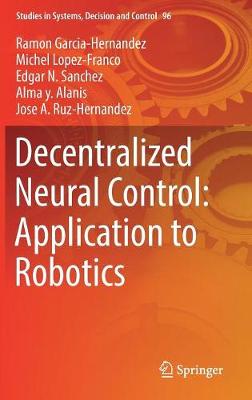Studies in Systems, Decision and Control
2 primary works
Book 96
Decentralized Neural Control: Application to Robotics
by Ramon Garcia-Hernandez, Michel Lopez-Franco, Edgar N. Sanchez, Alma Y. Alanis, and Jose A. Ruz-Hernandez
This book provides a decentralized approach for the identification and control of robotics systems. It also presents recent research in decentralized neural control and includes applications to robotics. Decentralized control is free from difficulties due to complexity in design, debugging, data gathering and storage requirements, making it preferable for interconnected systems. Furthermore, as opposed to the centralized approach, it can be implemented with parallel processors.
This approach deals with four decentralized control schemes, which are able to identify the robot dynamics. The training of each neural network is performed on-line using an extended Kalman filter (EKF).
The first indirect decentralized control scheme applies the discrete-time block control approach, to formulate a nonlinear sliding manifold.
The second direct decentralized neural control scheme is based on the backstepping technique, approximated by a high order neural network.The third control scheme applies a decentralized neural inverse optimal control for stabilization.
The fourth decentralized neural inverse optimal control is designed for trajectory tracking.
This comprehensive work on decentralized control of robot manipulators and mobile robots is intended for professors, students and professionals wanting to understand and apply advanced knowledge in their field of work.
Book 278
Neural Control of Renewable Electrical Power Systems
by Edgar N. Sanchez and Larbi Djilali
This book presents advanced control techniques that use neural networks to deal with grid disturbances in the context renewable energy sources, and to enhance low-voltage ride-through capacity, which is a vital in terms of ensuring that the integration of distributed energy resources into the electrical power network. It presents modern control algorithms based on neural identification for different renewable energy sources, such as wind power, which uses doubly-fed induction generators, solar power, and battery banks for storage. It then discusses the use of the proposed controllers to track doubly-fed induction generator dynamics references: DC voltage, grid power factor, and stator active and reactive power, and the use of simulations to validate their performance. Further, it addresses methods of testing low-voltage ride-through capacity enhancement in the presence of grid disturbances, as well as the experimental validation of the controllers under both normal and abnormal grid conditions. The book then describes how the proposed control schemes are extended to control a grid-connected microgrid, and the use of an IEEE 9-bus system to evaluate their performance and response in the presence of grid disturbances. Lastly, it examines the real-time simulation of the entire system under normal and abnormal conditions using an Opal-RT simulator.

